Responsible Management Report 2020
7.4.5. We reconnect by being environmentally responsible
E
S
G
(GRI 201) (SDGs 9, 11 y13)
For the Company, environmental management represents benefits including a competitiveness factor, as well as important opportunities to generate efficiency in the consumption of the resources associated with the telecommunications network and sales management.
In the sustainability context, Telefónica Movistar is committed to contributing to the global goals of the Paris Climate Agreement and the Sustainable Development Goals of the United Nations 2030 Agenda.
The Company is committed to corporate responsibility and interested in the sustainable development of its activities and its relationship with the environment. Therefore, it has an Environmental Management System certified since 2007, which demonstrates that it meets the standards associated with the preservation and control
of impacts on the environment, risk control and legal requirements.
In 2020, through an external audit process conducted by AENOR INTERNACIONAL, certification of the Environmental Management System was obtained and the application of the ISO 14001 standard was verified, generating three minor non-conformances in the process, which did not affect the result.
The scope of the standard as an operator of mobile and fixed telecommunications and internet services is:
- Design, engineering, construction, management, installation, operation, maintenance and provision of telecommunications services (mobile, broadband, satellite TV and basic line) nationwide.
- Customer service.
The main contribution as a company to the mitigation of and adaptation to climate change is through the development and application of digital solutions, supported by an increasingly more efficient and sustainable network. Through the EcoSmart services and products that the Company offers, based on technologies such as the
Internet of Things and big data, it has managed to help reduce greenhouse gas emissions, as well as improving the management of natural resources.
This kind of service is aimed at improving mobility and promoting customers’ energy efficiency. These services take advantage of technologies to help companies to use scarce resources, such as energy or water, more efficiently; manage environmental aspects, such as waste, climate and air quality; and reduce CO2 emissions. Therefore, through technology, the Company provides intelligence to vehicles (smart transport), buildings (smart buildings) or meters (smart meters), among others.

Energy
(GRI 302-4) (SDGs 7 y 9)
The climate change risk has an impact on the Company’s global business strategy, due to the direct impact and the related risks and opportunities. Therefore, Telefónica Movistar’s energy and climate change strategy drives long-term value creation through effective risk management and making the most of opportunities.
The Company has a global corporate climate change strategy with quantitative objectives that are not only compatible with the expansion of the network and quality of service, but that will also help them to be more competitive. Therefore, as part of the Climate Action Agenda, some targets were set for 2025, driven by energy efficiency and climate change programs and initiatives, which have been validated according to the 1.5°C scenario by the Science Based Targets Initiative (SBTi):
More energy efficiency:
By 2025, reduce energy consumption 90% per traffic unit (MWh/PB) from 2015.
Achieve net-zero emissions by 2025 (Scopes 1 and 2) in the four main markets:
Spain, Brazil, United Kingdom and Germany. For operations in Hispanic America, the target is net-zero emissions by 2040.
With all the Eco Smart solutions ,
achieve that customers decrease five million tons of CO2 a year.
More renewable energy:
For Telefónica’s operations in Hispanic America, the target is to be 100% renewable by 2030. For the four main markets, the target is to keep consuming energy that is 100% from renewable sources.
Reduce CO2 emissions in the value chain
39% by 2025 and achieve net-zero emissions by 2040.
The energy resource is where the Company has the biggest opportunities to generate savings and efficiencies, through the implementation of an alternative and cleaner energy project. In 2020, thanks to the energy efficiency and fuel reduction initiative, we managed to save around COP 5 billion. Some notable initiatives are:
- Shutting down platforms and equipment associated with previous technology generations (2G), which enabled efficiency of more than 7 million KWh/year
- Expansion and upgrade of power equipment (rectifiers), increasing its efficiency level and achieving a reduction in energy consumption of 125,000 KWh/year
- Implementation of solar power systems in technical offices with high electricity consumption potential: Delicias in Barranquilla, Toberín in Bogotá and Buitrera in Cali, which generated 98,375 KWh/year of solar power.
- Energy projects as a service:
- Batteries as a service: Fuel consumption decreased 70% in radio bases that operate in areas of high irregularity in the electricity supply service.
- Off-grid sites: lectricity generation service through the implementation of hybrid systems (solar power system, lithium batteries, and generator) for off-grid radio bases, with a monthly reduction in operating costs of 53%.
- Power Purchase Agreement (PPA): In 2020, a PPA was signed between Sun Colombia and Movistar Colombia. This is the first in Colombia and the second in Hispanic America. With a term of 20 years, this contract aims to purchase renewable energy from the implementation and start-up of the solar power system located in the Celta building in Bogotá

With a term of 20 years, this contract aims to purchase renewable energy from the implementation and startup of the solar power system located in the Celta building in Bogota.
COP
5 billion
savings thanks to initiatives energy efficiency and fuel decrease.

In 2020, total energy consumption was 304,123 MWh, 2% less than in 2019. This consists of electricity and fuel consumption of operations, fleets and self-management
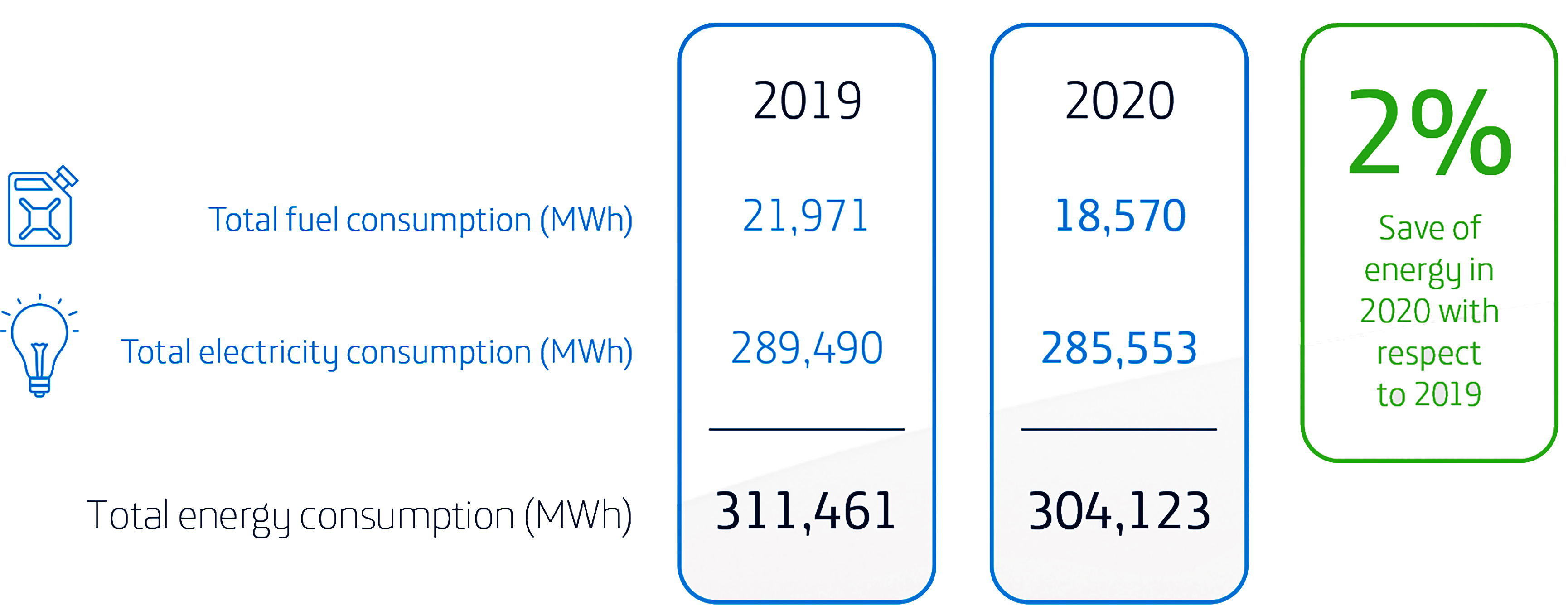
In 2020, electricity consumption amounted to 285,553 MWh, showing a 1% reduction in consumption in operating, administrative and sales buildings from 2019. This is a significant decrease, especially when taking into account the rollout and growth of the network infrastructure carried out in 2020, mainly resulting from the customers’ demand for services, especially due to the pandemic and the need to be connected.
1%
Reduction of electrical energy consumption in operational, administrative sites and commercial
58%
Of consumption total energy electric, it was coming of sources renewable
Out of the 285,553 MWh of electricity that the Company used in 2019, it generated 715 MWh itself though solar power systems. Additionally, 164,884 MWh were from renewable sources, which comprise 58% of total energy consumption. This electricity consumption is distributed
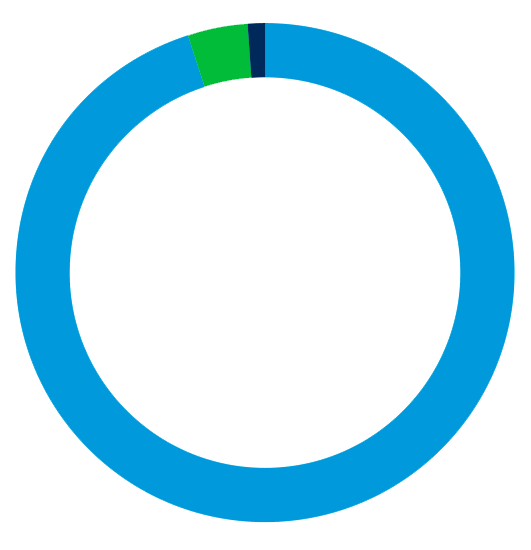
Consumption
distribution of energy
95%
4%
1%
Technical management
Commercial front
Offices
Fuel is another important source of energy for operations., It serves as a backup when the electricity supply is interrupted. In 2020, consumption was 1.7 million liters, that is a reduction of 11% from 2019, equivalent to 206,763 liters of gasoline/diesel. This occurred thanks to the implementation of more efficient equipment and the consumption controls of partners and suppliers in the supply to the national grid.
11%
Reduced fuel consumption
Similarly, in recent years, the Company has also made great efforts to reduce fuel consumption in the vehicle fleet, using increasingly lower consumption vehicles and improving the management of fleets by using M2M solutions, which nvolve efficient driving techniques, reducing the kilometers traveled and gradually incorporating electric cars. Particularly, during 2020, there was a 51% reduction, because the majority of the fleet was redundant due to the COVID-19 pandemic.



Emissions
(GRI 305-1, 305-2, 305-3, 305-5) (SDGs 7, 13)
Based on the annual analysis of energy consumption, the carbon footprint of all the Group’s operations is calculated using the methods of the GHG Protocol, the ISO 14064 standard and Recommendation ITU-T L.1420 (methodology of the International Telecommunication Union for measuring information and communication technology related to energy consumption and greenhouse gas emissions).
Additionally, an independent process of verification of energy and emissions data is carried out to obtain quality information about the energy that the Company consumes and the greenhouse gases that it emits into the atmosphere during its activities. This has enabled the identification of improvements in the processes and transparent management of energy and carbon dioxide. Similarly, achievement of the global energy and climate change goals is assessed through this quantification and verification.
The aim is to align the Company’s efforts with the required level of decarbonization to limit global warming to below 1.5°C. For this, the global target is to achieve net-zero emissions by 2025 (Scopes 1 and 2) for the Group’s four main operations, hoping to achieve this goal in Hispanic America by 2040 at the latest.
The Company’s carbon footprint mainly comes from energy consumption, so Telefónica Movistar has progressed in the implementation of the Energy Efficiency Plan, which consists of the development of specific projects for reduction, replacement and consumption of renewable energy as an initiative against climate change.
Through the implementation of an ambitious energy efficiency program, the Company has reduced carbon emissions by 48% since 2015, i.e., around 26,354 tons of CO2. Similarly, thanks to the renewable energy consumption model implemented since 2019, there was a significant year-on-year reduction of 8% from 2019, i.e., 2,560 tons of CO2 were no longer emitted, and currently, 61% of energy consumption comes from renewable sources.
8%
Reduction year on year of emissions of carbon with respect to 2019
61%
Of consumption of energy comes from of sources renewable
48%
Decrease emissions carbon since 2015
| 2015 | 2016 | 2017 | 2018 | 2019 | 2020 | |
|---|---|---|---|---|---|---|
| Direct CO² emissions (Scope 1) | 18,897 | 17,534 | 16,814 | 15,025 | 12,036 | 12,689 |
| Indirect CO² emissions (Scope 2) | 35,463 | 36,436 | 36,153 | 35,499 | 18,530 | 15,317 |
| Total CO² emissions (tons) | 54,360 | 53,970 | 52,967 | 50,524 | 30,566 | 28,006 |
The Company agreed the purchase of Renewable Energy Certificates with two partners until 2021, which ensured the responsible environmental origin of 58% of the total electricity consumed by the organization during 2020. These initiatives demonstrate the Company’s commitment, as well as its leadership in sustainable development and in the reduction of the carbon footprint, responding to the call of the COP21 Paris Agreement, where the Company committed to reduce GHG emissions 20% by 2030. This responsibility is transferred in the same way to all sectors of the industry.
Waste management
(GRI 306) (SDG 12)
In 2020, there was a 23% reduction in waste generation from the previous year. Mostof the waste generated is from operations, due to network maintenance and the electricity backup systems. Around 971 tons of waste were managed, of which 870 tons (90%) are non-hazardous: 39% is comprised of cable, plastic pipe and metal waste; 44% of waste from electrical and electronic equipment (WEEE), which can come from operations or customers, such as equipment that they no longer use (modems, decoders and cellphone devices); and
7% of paper and cardboard waste. Additionally, 101 tons of hazardous waste were generated, which comprise 10% of the total, such as batteries, fluorescent waste, refrigerant gases and oils, etc. Due to the characteristics of hazardous waste, it cannot be reincorporated into operations, but it is used as a raw material for other productive processes.
The Company has the support of specialized and duly authorized partners for the adequate management, handling, transport and disposal of hazardous and special waste.

| TYPE OF WASTE | UNIT | 2019 | 2020 |
|---|---|---|---|
| Paper and cardboar | Tons | 124.9 | 64.1 |
| Cables. plastic pipes and metals | Tons | 768.9 | 376.9 |
| WEEE from operations and offices (non-hazardous) | Tons | 158.0 | 320.2 |
| Customer cellphones (tons) | Tons | 22.8 | 28.5 |
| Customer WEEE (except cellphones) | Tons | 76.1 | 80.2 |
| Fluorescent waste | Tons | 1.9 | 0.6 |
| Batteries | Tons | 72.5 | 43.9 |
| Other hazardous waste | Tons | 18.5 | 11.3 |
| Used oils (tons) | Tons | 13.4 | 18.0 |
| Refrigerant gases and their equipment | Tons | 3.1 | 9.1 |
| WEEE from operations and offices (hazardous) – CRT screens. with PCB. with oils |
Tons | 0.4 | 17.8 |
| Total (tons) | 1.260 | 971 |
Although waste management depends on the authorization generated in the environmental licenses of the managers that support it, the Company has a priority waste management chain, where the first treatment must be focused on its reuse, recycling or use. In cases which due to access to the area, type or characteristics of the waste, this measure cannot be implemented, the Company will opt for the use of the method of disposal in a safety cell and/or landfills and incineration. Thanks to this, the Company has identified and assessed the companies (managers) that meet all the legal environmental requirements and whose permitted activities include the use or recycling of waste as a priority.
A total of 95.4% of the waste was recycled, while 4.5% was disposed of in a safety cell.
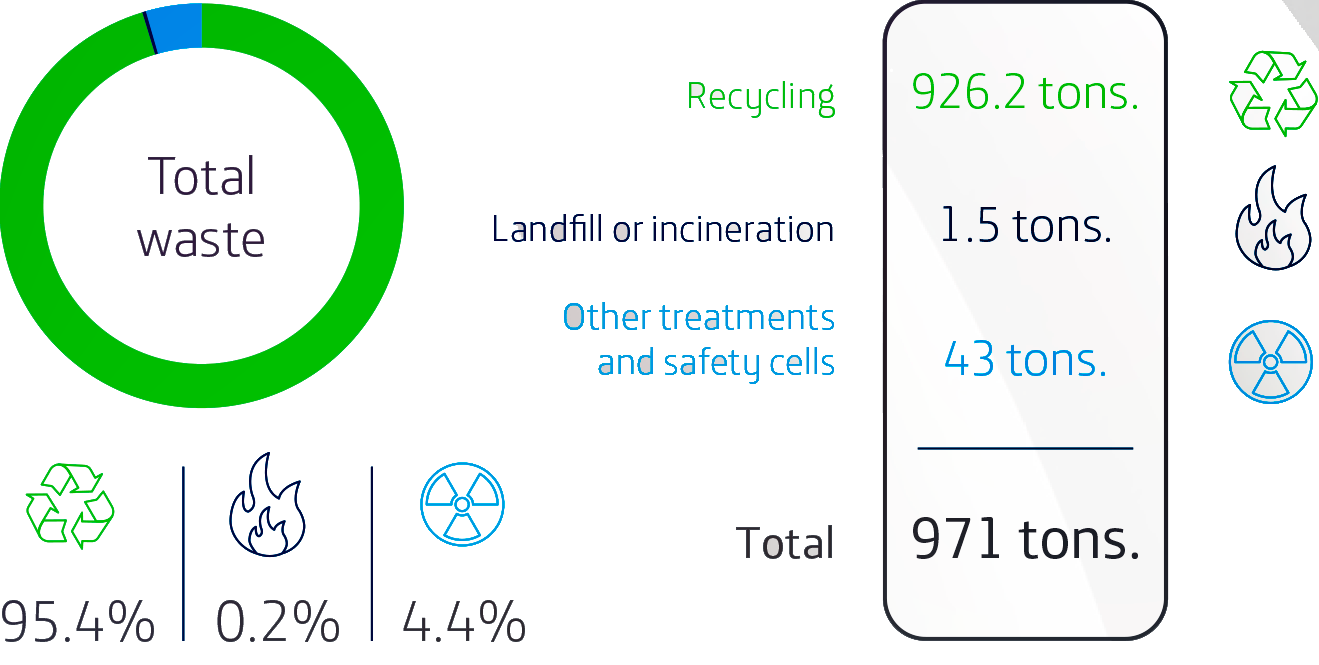

Water

(GRI 303-5)
Although the water consumption of Telefónica Movistar’s operations is low and is mainly related to sanitary use, and to a lesser degree to the equipment cooling systems, a responsible consumption strategy has been implemented, which seeks efficiencies and the reduction of the consumption of this resource.
n 2020, the Company’s water consumption was 115,903 m3, which comprises a 30.7% reduction from 2019.This decrease is due to causes including the organization issuing the work from home policy for employees during the pandemic, so their attendance at the offices was reduced. It is also due to the actions carried out
by the administrative department for the early detection and control of leaks, cancellation of accounts, identification of third parties’ consumption, collection of rainwater for the watering systems in the administrative offices and bathrooms, as well as the employees’ participation in the environmental awareness-raising campaigns during the first months of the year.
The Company uses water from the municipal waterlines. Although its water consumption is not material or significant for the Company’s operation, the water resource is of vital importance to manage efficiencies, especially when combating the effects of climate change in the country.
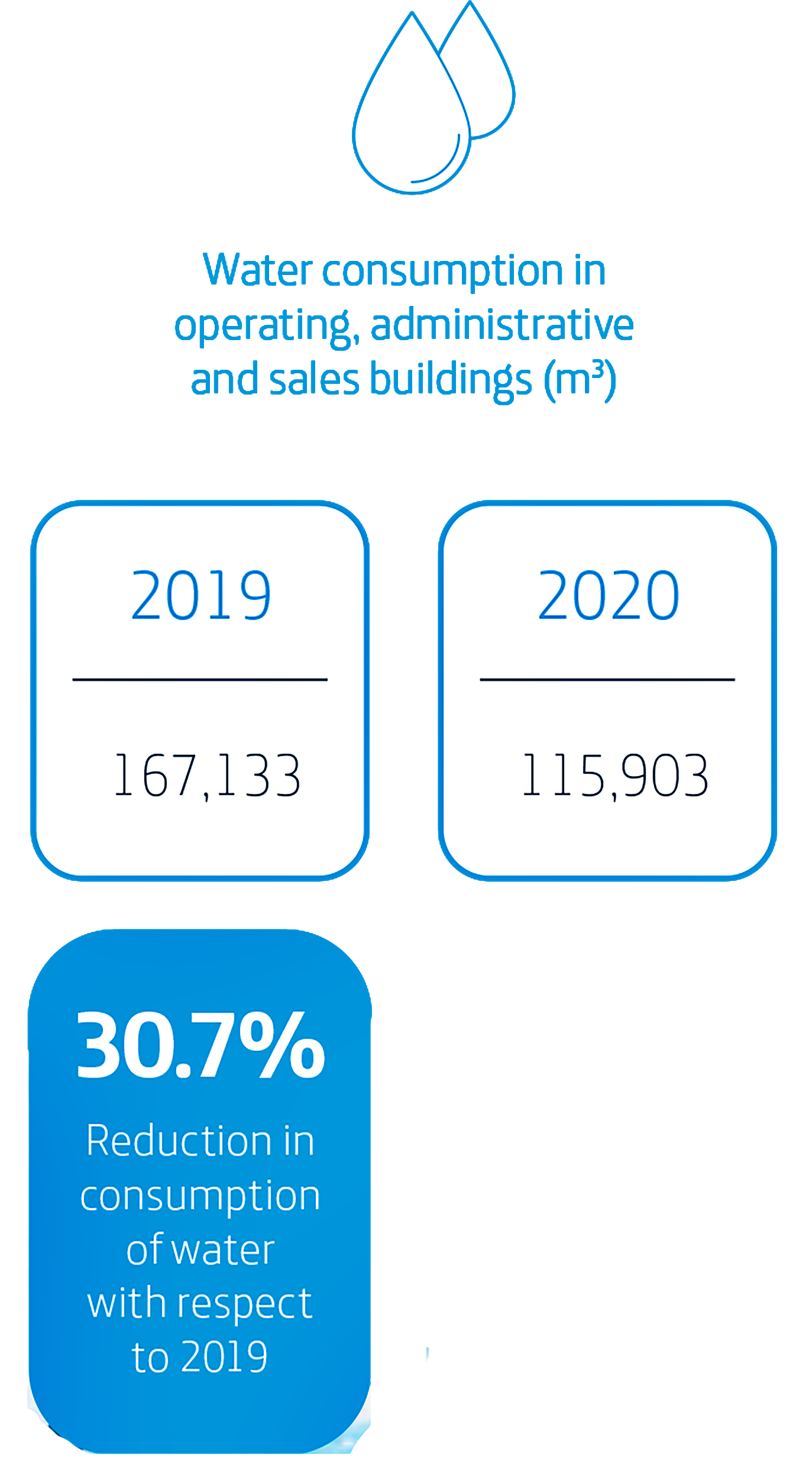


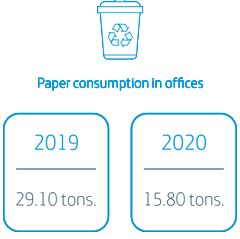
Paper
(SDG 12)
One of the Company’s investments in this area is the digitalization of the administrative and commercial processes: Rationalizing the use of paper and controlling printouts per user, printing targets per building, inclusion of printing hub points, and review and adjustment of processes.
In 2020, the Company received an acknowledgment from SONDA and CO2CERO for its environmental contribution and they encouraged Movistar to sponsor the planting
lof 50 trees in Puerto Gaitán, Meta, which will capture more than 55 tons of CO2 over the next 20 years.
With this initiative, the Company has sought for customers to have a more digital experience in the experience centers, as well as speeding up the sales processes through the use of the Mi Movistar App, which also helped to reduce the risk of identity theft.
In 2020, paper consumption amounted to 15.8 tons, i.e., 46% less than in 2019:
In 2020, the Company received an acknowledgment from SONDA and CO2CERO for its environmental contribution and they encouraged Movistar to sponsor the planting of 50 trees.
Similarly, the Company kept digitalizing its processes, including billing for customers. By the end of 2020, more than 4.9 million customers had migrated to a digital bill, which comprises 93.7% of the total customer base.
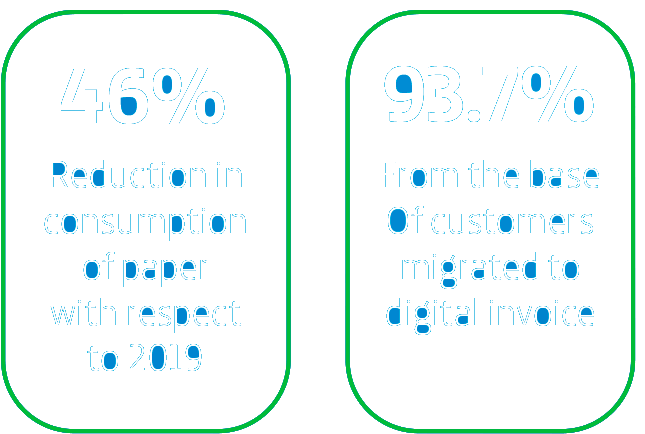
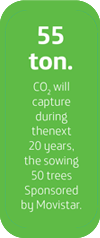
Sustainable mobility
During 2020, the Company adjusted and presented its Comprehensive Mobility Plan (PIMS, for the Spanish original), which is based on the district mobility strategy driven by the Bogotá Mayor’s Office. The aim of this plan is to drive the sustainable and safe mobility of its employees and supply chain, as well as promoting digitalization in the use of bicycles or shared vehicles (carpool) through a survey that enables the Company to know the mobility dynamics of its employees, coordinating and designing the best sustainable mobility strategies for them. This document went through an evolution and approval phase (with 73.5 out of 100 points) by the District Secretary of Mobility. Therefore, Telefónica Movistar joins the group of organizations that have an approved and effective PIMS to implement between 2020 and 2021.
The components of structuring the plan and communicating the initiatives stand out in the assessment, and the component of mobility strategies to implement is an area for improvement.
Precautionary principle or approach
(GRI 102-11)
Telefónica Movistar complies with the precautionary principle, which is part of Colombian regulation with respect to the limits of people’s exposure to electromagnetic fields in the rollout of telecommunications infrastructure (Decree 195/2005 and ANE Resolution 754/2016). Similarly, it complies with all the Colombian provisions regarding the environment (Law 99/1993) when the rollout is carried out in environmental protection areas.
Compliance
(GRI 419-1)
During 2020, the Company did not receive any fine or penalty related to breach or violation of the Colombian environmental regime. As mentioned above, the Company has the ISO 14001 environmental certification since 2007, and it adequately manages and responsibly disposes of all the waste it produces.
Telefonica Movistar complies with the precautionary principle, which is part of Colombian regulation with respect to the limits of people’s exposure to electromagnetic fields in the rollout of telecommunications infrastructure.
